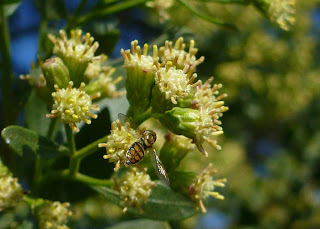You know that buzz - that buzz when you walk into a room and the party is in full swing? I heard that buzz recently while stepping onto the bridge over the Arboretum wetland. It made me stop and look for the party. The groundsel bush (Baccharis halimifolia) was in full bloom, hosting the most diverse party of pollinators I've seen in awhile. Many species of butterflies, moths, flies, bees, and wasps, visiting each flower, all very busy collecting nectar and pollen. So busy they didn't even notice the humans walking by!
This busy lady has been visiting long enough to pack her pollen baskets full of tasty, nutritious groundsel pollen. I can hear you - bees carrying baskets full of pollen - this lady is a big fanciful, I think. Well, if you can see the bright orange-yellow circle in the center of the picture, that is actually a pollen basket, a structure bees have on their legs made specifically to hold the collected pollen for the flight back to the hive.
This is an interesting visitor because at first glance you might say it was a bee of some sort when, in fact, it is a fly masquerading as a bee! The telltale in this case is the presence of only one set of wings, which is a characteristic of flies. Bees and most other insects have two sets of wings. Demonstrating an excellent use of biomimicry strategy, these flies gain protection from predators by using a disguise of an insect known to have formidable defenses without having to go to the physical cost of maintaining the venom and stingers of their models, the bees.
For a nice discussion of bees, bee mimics, and how to identify them, you can visit
http://beespotter.mste.illinois.edu/topics/mimics/
http://beespotter.mste.illinois.edu/topics/mimics/
I included this last picture because who doesn't like a butterfly
picture?
Listen for the party buzz the next time you come to the
Adkins Arboretum and see if you can spot a bee mimic while you are here.
Post and photos by Arboretum docent Michelle Dolan Lawrence



No comments:
Post a Comment